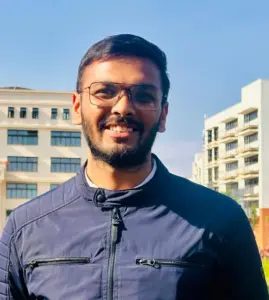“What are the opportunities available for us after we graduate?” is a question that is in every student and their parents. A valid question indeed, in the rapidly changing world. In response to this question, Ajai Narendran, a senior faculty member at SMI, says that “the integration of scalable, reconfigurable, and transferable skills throughout the curriculum at SMI enables students to develop the confidence and capability to venture into and engage with new and unfamiliar domains. These skills equip them to navigate change and thrive in diverse professional and career contexts.” They can apply the capabilities and skills into other fields that they might want to pursue. Graduates can easily move into different domains than the one they majored in. Another senior educator, Mahesh Bhat often reminds students that they are not necessarily what their degree certificate says, but they are what they love. To illustrate this thought, here are four non-linear journeys of our alumni!

Achal Jadhav (Srishti Foundation Year 2015), MD (University of Minnesota School of Medicine, USA)
LinkedIn
“You’re just not a science person.” I heard this so often that I started to believe it. After struggling through high school, my academic confidence couldn’t have been lower, nor my career prospects slimmer. Srishti was a shot in the dark, and one that I’m so glad I took. The curriculum pushed me to the edge of my comfort zone in an environment that was conducive to growth. The students were collaborative, the faculty supportive, and the curriculum boundless. Even though it is an Art& Design school, it was where I rediscovered my confidence in and love for science. I’m now in my final year of medical school (MD 2022-2026, University of Minnesota Medical School, USA), eager to start my career as a doctor. Despite being at Srishti for only one year, its impact has stayed with me for over a decade.

Ananya Rane (B.Des, 2021), MBA (SP Jain Institute of Management & Research, Mumbai)
LinkedIn
When I think back to my time at Srishti, I’m full of memories of how we were encouraged to experiment, to choose our own paths, and how nothing was ever considered “wrong.” I chose human-centred design as my major, but my courses spanned everything from coding and systems design to illustration and even weaving! At the time, I took them simply because they seemed interesting, but today, I see the larger picture.
Now, in my MBA at SPJIMR, surrounded by peers from engineering, commerce, economics, and countless other disciplines, I realize how much studying design sets me apart. I’m the only design student in my batch, and it shows in the way I approach problems. Cracking the CAT is often seen as proof of sharp quantitative and analytical ability; and studying design never meant I had to leave that side behind. If anything, it strengthened it: balancing structure with creativity, logic with empathy, and math with meaning. Design doesn’t just train you in tools or crafts; it makes you comfortable when there’s no structure, it teaches you to keep an open mind, and most importantly, it instils empathy.
These qualities – empathy, openness, and comfort with ambiguity – are often missing in business conversations but are crucial to creating real impact. In the MBA classroom, this difference becomes clear: where others look for frameworks, I also look for people; where others seek efficiency, I ask about experience.
Even though what I do now may not look “like design,” I know the practitioner I will become will be sharper and more grounded.

Samyukta Jayaram ( B.Des, 2023) MS (Design of emerging technologies, University of California, Berkeley on a full distinguished merit scholarship)
Linkedin
Srishti gave me the space to explore design in its broadest sense. Though my concentration was Industrial Arts and Design Practices, the interdisciplinary structure of the program allowed me to take courses across disciplines, from systems thinking and speculative futures to emerging technologies and science communication (and much more!). It helped me develop a creative practice that made even the most complex design challenges feel approachable.
The studio-based learning model at Srishti encouraged experimentation, collaboration, and critical thinking. We were challenged to engage with real-world problems, work with affected communities, take creative risks and approach design as an iterative, inquiry-driven process. We learnt to design with intention, always asking why, for whom, and for what impact.
My journey at Srishti has now led me to pursue a master’s in design in Emerging Technologies at UC Berkeley, as a recipient of the Distinguished Scholar Merit Award. More than just teaching design as a subject area, Srishti shaped how I think, question, and respond as a design practitioner – something that will continue to guide my work as I take the next step in my career.
https://design.berkeley.edu/profiles/samyukta-jayaram

Piyush Jain ( BFA, 2022), Master in Management (MIM), EDHEC Business School, France
LinkedIn
My time at Srishti was a period of radical transformation, of learning self expression, and becoming an independent thinker. The courses were very multidisciplinary, always leading me to explore new perspectives and to make connections between topics of study. But above all, it was the faculty, how open they were, how they gave us feedback, and how they pushed us while still making us feel cared for.
Everyone has their own set of challenges, those days when managing social or personal issues seemed to take an unbearable toll, the Wellness Centre was a reassuring anchor that really helped. Stepping out of Srishti, I had learned how to learn, and had increased confidence, understanding, and sensitivity.
Currently, I am pursuing a master’s in management at EDHEC Business School, France. My experience in Srishti also encouraged me to develop life skills to thrive in an international environment, along with transferrable skills like critical thinking, effective collaboration and communication, that I find increasingly important to be ready tor the future.

